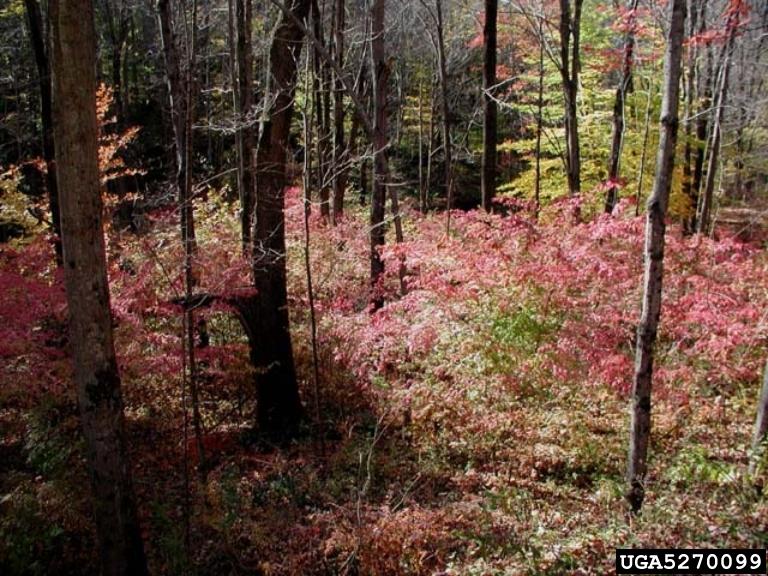The name of this issue’s invasive plant species may result in some verbal gymnastics. The combination of leading vowels and Y in the middle does not necessarily roll off the tongue. Consequently, this species, the genus of which is pronounced “Yoo-ON-ih-mus,” is more commonly known by a variety of descriptive nicknames. The most common is “burning bush,” but it is also known as “winged burning bush,” “winged spindletree,” “winged wahoo,” and others.
Not matter its name, this particular invasive is not widespread in the mid-Atlantic. Its greatest reported infestations are in the Midwest and Northeast. In 2020, it was found in much of central and southern Pennsylvania, far northern Delaware, southwestern Virginia, north-central West Virginia, and the greater Washington DC area. See the distribution map below.

By 2025, it had spread into the Canadian province of Ontario and to all but four counties (Kent, Dorchester, Somerset, and Worcester) in Maryland. See the map from the Maryland Biodiversity Project below.

What is it?
Winged euonymus (euonymus alatus) was introduced to the United States in the mid-1800s from Asia as an ornamental plant for landscaping. It is native to central China, Japan and northeast Asia. It is still available commercially under several varieties, and continues to be planted around buildings, along roadsides, and in residential settings. Some examples of this shrub have grown up to 20 feet in height. From these intentional plantings, it has escaped into woodland edges, into mixed deciduous forests, and into disturbed sites such as roadsides or new construction.
The plant needs full to partial shade to thrive, but can survive shaded areas with the proper soil conditions. It withstands a wide range of soil types, except areas that are wet and poorly-drained. Given the proper conditions, it forms dense thickets and can out-compete native plants.
Winged euonymus is now considered invasive in several states. For example, in Maryland it is regulated by the Maryland Dept. of Agriculture (MDA). Retail stores that offer it for sale are required by MDA to display information that designate it is an invasive plant.
How does it spread?
This invasive plant spreads widely under ideal conditions. It generates numerous seedlings, and birds disperse the seeds by consuming its berries. The seeds can remain viable in the soil for many years.
How can I identify it?
Winged euonymus has a variety of distinguishing features. Its bright red autumn foliage has led to the “burning bush” nickname. Identification in other seasons is made easier by the branches’ characteristic winged stems and by its dark green oval leaves, which have tapered tips. The small red berries appear from September to October. See the image gallery below.
How can I control it?
Manual, mechanical, and chemical methods have proven effective in controlling winged euonymus; often a combination is needed. Pull the seedlings as soon as possible after they sprout; they may be numerous beneath an established shrub. Established plants should be pulled before they begin to generate berries. Cut the shrub to the ground to control re-sprouting; the process may need to be repeated. Herbicide applications are most effective in late summer through fall to allow the chemicals to be transported into the root systems as the dormant season approaches. Applications using cut-stump or foliar spray methods are effective. Mutli-stemmed shrubs will require more than one foliar spray applications to ensure that the herbicide reaches the root systems of each stem.
For more information:
Learn more about Winged eunonymus:
Q&A: Is Burning Bush an Invasive Plant? - Maryland Grows blog
Winged Burning Bush (Plant Invaders of Mid-Atlantic Natural Areas) - invasive.org
Invasive Plants in Pennsylvania: Burning Bush - Pennsylvania DCNR
